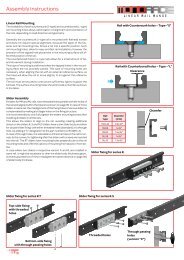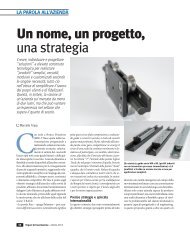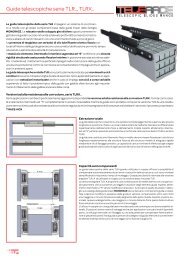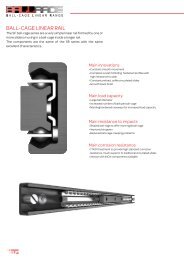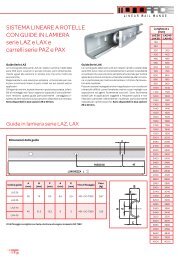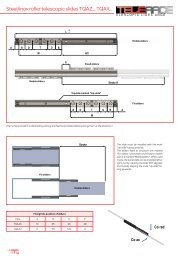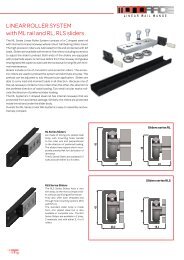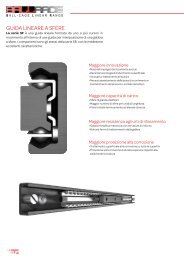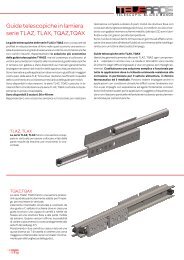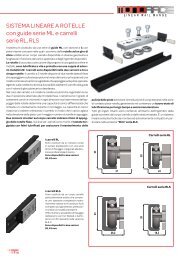general catalogue - T RACE SpA
general catalogue - T RACE SpA
general catalogue - T RACE SpA
You also want an ePaper? Increase the reach of your titles
YUMPU automatically turns print PDFs into web optimized ePapers that Google loves.
Thrust force<br />
The force required to move a slider is contingent on several factors, which are summarized to each other<br />
in releation to the application. I.e. the actual load applied, the direction of the load, the preload setting of<br />
the slider, friction of wipers/lateral seals and bearing seals. In principle the slider, when preload in rail without<br />
a load applied, may require a thrust force of Fw, which is mainly due to the preload setting, than friction<br />
caused by wipers. Especially the friction generated by wipers/lateral seals/preoiled sponges tends to<br />
decrease after an initial period, as adapting their shapes the raceways. If removing the wipers, the thrust<br />
force Fo is then only based on the slider preload setting. The thrust<br />
force from slider preload setting may varie along the rail, due to minor<br />
parallellism tolerance of the rails internal raceways.<br />
The thrust force Ft of the slider with a radial load P applied, is approximately<br />
proportional to the load as a coefficient function of friction<br />
of the wheels, increased by the thrust force Fw from wipers and<br />
preload setting.<br />
Ft =(P x μ)+Fw<br />
In case that slider is without wipers the value Ft results by:<br />
Ft =(P x μ)+Fo<br />
The below table shows the indicative values of Fw and Fo of a minimum<br />
value and a maximum value, depending on the preload setting<br />
of the slider. The result of Ft simplified formula is reasonably valid for<br />
applied loads greater than 10% of the maximum permissible load.<br />
For lower loads the coefficient of friction is increased up to twice the<br />
original value.<br />
P<br />
Ft<br />
Slider type<br />
Fo<br />
Static friction of slider without load<br />
and without wipers<br />
Fw<br />
Static friction of slider without load<br />
and with wipers<br />
μ μ<br />
Friction coefficient of rollers<br />
R.18 from 0,2 N to 0,5 N from 1 N to 1,5 N 0,005<br />
R.28 from 0,5 N to 1,5 N from 2,5 N to 3,5 N 0,005<br />
R.43 from 1 N to 3,5 N from 6 N to 10 N 0,005<br />
RL/RLS/R.S28 from 0,5 N to 1,5 N from 2,5 N to 3,5 N 0,005<br />
RL/RLS/R.S43 from 1 N to 3,5 N from 6 N to 10 N 0,005<br />
PAZ-PAX from 0,1 N to 0,6 N 0,008<br />
Noise and speed<br />
T <strong>RACE</strong>’s roller sliders offer high operating speed up to 10m/s, with almost no noise, when compared to recirculating ball-sliders. The table on right side, shows the max.<br />
speed for different slider types. The R sliders with wipers and lateral seals, may emit a minor friction noise at no applied load, which however tends to decrease during<br />
use, as the parts adapt to the shapes of the raceways<br />
Slider type<br />
Max. speed<br />
R.18 5 m/s<br />
R.28 7 m/s<br />
R.43 10 m/s<br />
RL/RLS/R.S28<br />
7 m/s<br />
RL/RLS/R.S43<br />
10 m/s<br />
PAZ-PAX<br />
5 m/s<br />
35



